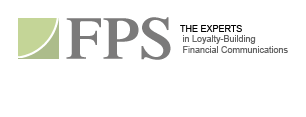 |
 |
| JULY 2007 |  |
What we do |  |
Work Samples |  |
FPS Resource Library |
|
Dynamic Relationship Pricing — the Next CRM Strategy? While research suggests that customers are more sensitive than ever to price, discounting is not necessarily the path to profitability. A 1% price cut must generate an increase in sales volume of at least 3.6% to be a profitable move. So, in most cases — according to Sunil Gupta and Donald Lehmann, authors of the 2005 book Managing Customers as Investments: The Strategic Value of Customers in the Long Run — there is no bottom-line benefit to cutting price. Over the long term, a culture of discounting can actually erode your brand and increase customer price sensitivity. In other words, lower prices provide higher value to the customer but decrease the value of the customer to the bank. Optimal pricing structure would increase both the customer's value to the bank as well as the bank's value to the customer. Gartner Research has coined the term "Dynamic Relationship Pricing" (DRP) to describe a pricing strategy that achieves this win-win scenario. Driven by the total customer relationship In its 2005 report, "Dynamic Relationship Pricing to Be Banking's Next CRM Strategy," Gartner describes DRP as "pricing that is both dynamic and driven by the total customer relationship." While banks have been using "dynamic pricing" for some time — adjusting rates according to changing market conditions — Dynamic Relationship Pricing goes a step farther. It factors relationship profitability into pricing and enables adjustments to ensure that pricing and rewards are aligned. DRP offers bundled, personalized solutions priced to reflect the customer's current and predicted relationship value with the bank. It can also take the form of fee waivers or other concessions based on the breadth and depth of the customer relationship. In order to structure pricing in this way, customer relationship knowledge from the CRM system or other customer database must be linked to profitability and costing analytics. More importantly, sales, marketing and product must understand how this information translates into value for the client across business lines. Gartner finds DRP pricing structure to be particularly beneficial to corporate clients: "Corporate and wealth clients will value the shared benefit of dynamic relationship pricing and will welcome the ability to control the cost of services through aggregating more business with one bank," its report says. Aggregating the right customer data is essential to carrying out these kinds of cross-boundary initiatives successfully. Gartner cites three major challenges to implementing such initiatives:
Aggregating meaningful data A good place to find the most valuable customer information you already have may be within the records of your call center. Not only can this be the starting place for your new customer data bank, but reacting to its content can drastically improve the customer experience. By sharing and analyzing call center interactions with marketing, sales, product development and even senior management, you can pinpoint the service bottlenecks and information gaps that most often generate the customer calls. Constructive changes can be made accordingly, resulting in happier customers and reduced call volumes. Centralizing and formatting data Formatting the information with unified definitions and fields for interdepartmental use is called master data management (MDM). Without MDM, silos will prevail, according to Gareth Herschel, Gartner's CRM Research Director. Herschel outlines each step in the MDM process:
Finally, the cross-functional team must translate the value proposition of the master data to the entire organization, as all must be continually involved in keeping the data accurate throughout changes in the customers' lifecycle. Establishing customer segments It's ironic that elevating the customer experience requires merging the bank's internal departments while simultaneously dividing customers and prospects into separate groups. Customers want relevance; to deliver it, you need to treat different customers differently through segmentation. An effective segmentation model identifies distinct groupings of customers with similar characteristics. Initially, your segmentation process will start with whatever information you already have in your database. But with consistent effort you can quickly build on your customer profiles to the point where you'll begin to identify client lifecycles, present and future. According to Omniture, a provider of Web analytics solutions, the larger "buckets" of information might be categorized into demographic, psychographic and behavioral groups. The demographics tell us who; the psychographics tell us what they think and feel; and the behaviors reveal the actions they take as a result. This knowledge empowers marketing to create more relevant messaging, enables sales to better bundle services, and gives product development the insights to anticipate and address client needs. By understanding which products and services customers are using currently, you can make predictions about what they're most likely to need or value in the future. By charting behaviors, you can develop customer models and extract "propensity to buy" scores. You might offer high-value customers open access to specialists in the contact center, or 800 numbers and access to advanced service features on the bank's Web site. Conversely, these customer models also can uncover profiles of customers most likely to defect. Combined with an overlay of customer profitability scores, you may decide to migrate less desirable customers to less costly channels, or deter them with higher service fees. All of this enables lower operational costs for higher returns over the long run. . . . Financial Publishing Services Co. If you are not already a MarketScope subscriber, please request your own free monthly edition. |
|


 Subscribe to MarketScope RSS Feeds
Subscribe to MarketScope RSS Feeds